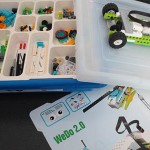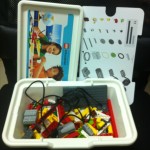Planning on introducing the LEGO WeDo into your class? Here are some ideas on what you need to get started.
Note: This guide is for LEGO Education WeDo 2.0, which comes in a blue container. The classic version of WeDo (white container) is no longer sold by LEGO Education but might be available from third parties. For a guide to that set, see What to buy (WeDo 1.0).
Hardware
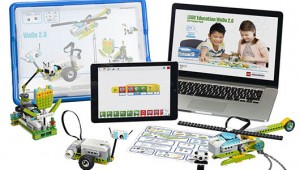
The LEGO Education WeDo 2.0 Core Set (product number 45300) comes in a stackable, blue plastic container with sorting trays and labels that help students keep the pieces organised. The 280 pieces in the kit include two sensors (tilt and motion), a motor, and a USB hub.
Generally, it is best to have one kit for every two students (although groups with up to four students per kit have been known to work). Smaller groups give students the chance to actively participate in building and programming and promote collaboration, while limiting idle time. For a class of 30 students, plan on 16 kits, including one kit for the teacher. You might want to consider purchasing a rechargeable battery pack (product number 45302) for each set so that you can reduce reliance on throwaway batteries. In this case, several chargers will be necessary as well.
Software
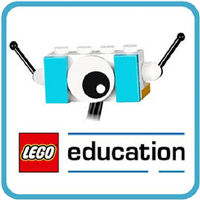
The WeDo 2.0 Software is free to download and supports most operating systems and devices, including Mac and Windows computers, Chromebooks, Android tablets, and iPads. The software includes teaching guides and curriculum packs for teachers, as well as building guides, assistance with programming, and engaging videos for students. One device per group would be ideal.
Hardware requirements to run the software can be found here and links to download the software can be found on LEGO Education Downloads.
Other considerations
- It’s nice to have a projector attached to your computer to display the software and activities while teaching.
- Storage will be necessary for the kits. If students are working on projects over several lessons, storage for partially completed projects will be necessary as well.
- Space for building and testing robots will also be necessary. This can be done on desks, perhaps a couple desks pushed together, but to reduce the possibility of damage, advise students not to let their robot crash on the floor. Students might also sit on the floor to build and test their robots, but students will need to be mindful of computers/tablets on the floor as they walk from one location to another.
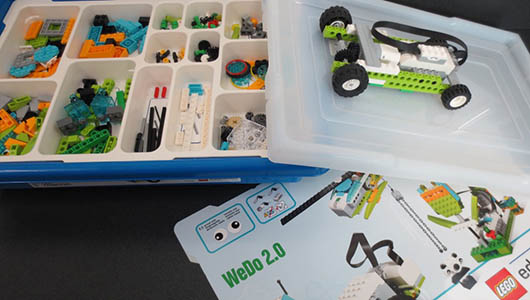
See also Get Started with WeDo.
Wayne Burnett
Latest posts by Wayne Burnett (see all)
- Hour of Code With Robotics - 2 December 2018
- Alternative Programming Languages for LEGO MINDSTORMS - 29 November 2018
- WeDo Sensors - 21 March 2018
- What to Buy (WeDo 2.0) - 1 March 2018
- Online Training Courses - 31 October 2017
